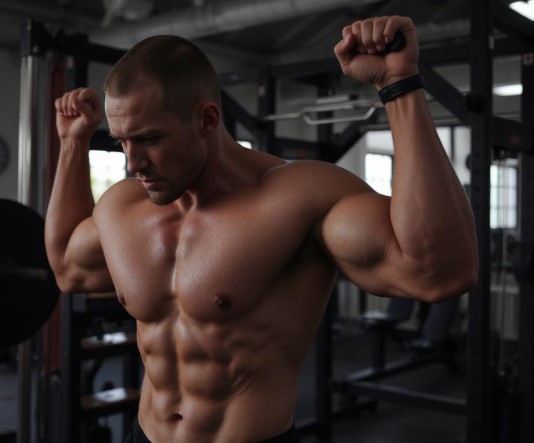The Best Workout Split Routines for FAST Muscle Gain
The Best Workout Split Routines for FAST Muscle Gain
Ever wondered how to make your gym time really count?
A workout split routine organizes your training so you hit specific muscle groups on different days. It’s like a game plan for getting stronger or building muscle without burning out. (This article breaks down the best splits to match your goals.) Whether you’re new to the gym or a seasoned lifter, there’s a split that fits your vibe.
Let’s dive in and find the right one for you.
Workout splits aren’t just for fitness buffs. They help anyone make their workouts more effective and keep things fresh. A good split balances hard work with rest, so you’re not wrecking yourself. And who doesn’t want to feel stronger and more confident? Stick with us to learn the top options and how to pick one that works.
First, Here’s How Workout Split Routines Work
So, what’s a workout split anyway?
A workout split plans your gym sessions by focusing on different muscles each day – like legs one day, chest the next. This lets your muscles rest while you work others, which is key to avoiding injuries. Splits give your workouts structure, so you’re not just picking exercises at random.
Why use a split?
It brings purpose to your training.
For example, a beginner might use a simple split to build strength, while an experienced lifter might choose a complex one to target specific muscles. Some also combine their routines with fitness-focused weight loss powders to support recovery and overall results. It’s all about matching the plan to what you want to achieve. (Pick the wrong split, and you might end up frustrated or exhausted.) Here’s what to consider before choosing:
- Fitness Level: Beginners need simple plans; advanced lifters can handle more.
- Goals: Are you after strength, bigger muscles, or better endurance?
- Schedule: How many days can you hit the gym each week?
- Recovery: Does your body need more rest between intense sessions?
These factors shape which split will work best for your lifestyle.

Popular Workout Split Routines
There’s no one perfect workout split – it depends on your goals and experience.
Each split has its own strengths, so let’s check out the most popular ones. You’ll see which might vibe with your routine. (Some are simple, others are intense.)
Here’s a breakdown of the top options.
Full-Body Split
A full-body split hits all major muscle groups in one session, usually 2-3 times a week. It’s great for beginners or people with tight schedules. You’re doing squats, bench presses, and rows in one go, working your whole body. This split is super efficient – you get a lot done fast. It builds a strong foundation before moving to more focused plans.
For example, picture a busy parent who can only hit the gym twice a week. They might do a full-body routine with compound lifts like deadlifts and push-ups, getting stronger without spending hours training. It’s simple but effective. But if you want bigger muscles, this split might not give enough focus to specific areas. Here’s why it’s awesome:
- Easy to learn and builds overall strength.
- Fewer gym days, but you still hit everything.
- More rest days between sessions.
Push-Pull-Legs (PPL) Split
The push-pull-legs split, or PPL, splits workouts into three types: push (chest, shoulders, triceps), pull (back, biceps), and legs. You can do it 3-6 days a week, depending on your time. It’s a favorite for intermediate lifters who want balanced growth. You might do bench presses on push day, pull-ups on pull day, and squats on leg day. Sounds pretty solid, right?
PPL groups related muscles together, so they recover at the same time. It’s great for someone past the beginner stage who’s ready to level up. But it needs more gym days than a full-body split, so you gotta commit. Here are its perks:
- Works all muscle groups evenly.
- Good for 3 or 6 days a week.
Upper-Lower Split
An upper-lower split alternates between upper body and lower body workouts, usually 4 days a week. One day you’re hitting chest, back, and arms; the next, it’s quads, hamstrings, and calves. It’s a great middle ground for intermediate to advanced lifters who want balance but more focus than a full-body split. (You get more recovery time for each muscle group.) It’s perfect for heavy lifting.

This split suits someone with a busy job but a regular gym habit. They might do upper body on Monday, lower on Tuesday, rest, then repeat. It’s less intense than a daily split but still lets you push hard, although UCLA Health warns about overtraining.
You’ll need at least 4 gym days, though. Its benefits include:
- Balanced recovery with Upper and lower muscles get solid rest.
- Moderate commitment of 4 days a week works for most people.
- Strength-focused since it’s ideal for heavy compound lifts.
- Speeds-up the muscle gain process.
- Isolates each muscle group without over-stressing and over-working.
Body Part (Bro) Split
The body part split, often called a “bro split,” targets 1-2 muscle groups per session, usually 5-6 days a week. Think chest day, back day, or leg day. It’s popular with bodybuilders chasing hypertrophy (muscle growth). You’re blasting one area – like biceps or shoulders – with multiple exercises for maximum pump. This one’s for folks who basically live at the gym.
Why choose a bro split? It’s all about sculpting specific muscles. But it’s time-intensive, so it’s not great for beginners or casual lifters. You’re in the gym almost daily, which can be tough to keep up. Here’s why it shines:
- Maximizes growth in specific muscles.
- Keeps workouts fresh with different muscle groups.
- Perfect for experienced lifters with time.
Workout Split Routines by Day
Deciding how many days you can commit to the gym is crucial for picking the right workout split. It’s not just about what exercises you do – it’s about fitting them into your life without burning out. A split that matches your schedule keeps you consistent, which is the real key to seeing gains. Too many days, and you might skip sessions; too few, and you may not hit your goals. Here’s how different weekly schedules shape your options.
Let’s break down three common splits by days per week:
- 3-Day Workout Split — Perfect for beginners or those with tight schedules, like a full-body or PPL split, hitting all muscles. Here’s a 3-day workout split that works for many gym-goers. This allows you enough rest between sessions.
- 4-Day Workout Split — Suits intermediates, often an upper-lower split. This 4-day workout split is the most popular one. It balances focus and recovery for steady strength or muscle growth.
- 5-Day Workout Split — Ideal for advanced lifters, like a body part split, targeting specific muscles daily for maximum hypertrophy but requiring more time.
For example: a busy professional who loves lifting but only has three gym days. They’d pick a split that maximizes those sessions, like a full-body routine, to stay on track. (Choosing the right number of days makes or breaks your progress.)
Choosing the Right Split
Picking a workout split is like picking the right tool for a job – it’s gotta fit what you’re trying to do. Are you aiming to get jacked, stronger, or just fitter? Full-body splits work great for beginners or those short on time, while PPL or upper-lower splits are solid for intermediates with a few gym days.
Advanced lifters might love the bro split for its muscle-specific focus.
It’s all about what keeps you motivated and fits your life.
Your schedule is a big deal. Only got two gym days? Go full-body. Got 4-5 days? PPL or upper-lower could be your jam. And don’t skip recovery – pushing too hard without rest can burn you out or hurt you. (Consistency beats perfection every time.) For example, imagine a teacher who’s been lifting for a year and wants bigger muscles. They might pick a PPL split, hitting the gym 4 days a week with bench presses, deadlifts, and squats, tracking progress to see gains without overcomplicating things.
Tips for Success
Once you’ve got your split, make it work for you.
Focus on compound movements – squats, deadlifts, bench presses – to get the most bang for your buck.
These hit multiple muscles at once, saving time and building strength. And don’t just coast; use progressive overload by gradually adding weight or reps. That’s how you grow stronger or bigger.
WebMD recommends listening to your body. Feeling wiped? Take an extra rest day – overtraining’s a real drag and can set you back. Adjust your split as your goals or schedule change… maybe switch from full-body to PPL as you get stronger. Track your progress; seeing those gains is super motivating. Here’s a quick rundown to nail it:
- Compound Lifts: Stick to squats, deadlifts, and presses for efficiency.
- Progressive Overload: Keep pushing with more weight or reps.
- Rest Smart: Give muscles time to recover to avoid burnout.
- Stay Flexible: Tweak your split if your goals or life change.
- Adjust On-the-Go: See what works and what doesn’t, then adapt.
- Track improvements: Observe muscle growth and weight increase.
Play The Long-Game with Your Workout Split Routines
Workout splits are a game-changer for making your gym time count.
They give you structure, help your muscles recover, and keep you focused on your goals. Whether you’re a newbie trying a full-body routine or a pro rocking a bro split, there’s a plan out there for you.
Why not start experimenting today? (Pick a split, stay consistent, and watch those gains roll in.)
You’ll be amazed at what you can achieve with a little planning.

